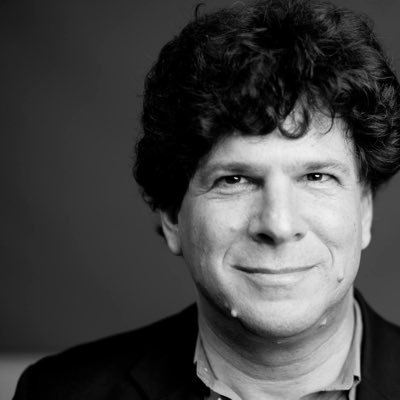UAP=SAP
The UAP = USAP hypothesis is a framework introduced by Eric Weinstein that interprets a significant portion of Unidentified Aerial Phenomena (UAP) reports as manifestations or consequences of Unacknowledged Special Access Programs (USAPs) within the United States government. It posits that many seemingly anomalous aerial sightings are either misidentified classified aerospace technologies or deliberate counterintelligence and deception operations associated with highly compartmentalized defense initiatives.
This concept is associated with terms such as "Cobalt" and "Baby" Blue-on-Blue, which describe the internal dynamics and fratricide-like conflicts that can occur when ordinary citizens and personnel without appropriate clearances unintentionally encounter or interfere with covert government operations.
Terminology[edit]
- UAP (Unidentified Aerial Phenomena): A term used by the U.S. Department of Defense and intelligence agencies to describe aerial objects or occurrences that do not conform to known technological signatures or natural explanations.
- SAP (Special Access Program): A category of classified program that imposes extra security protocols on access and dissemination beyond regular classification.
- USAP (Unacknowledged Special Access Program): A subset of SAPs whose existence is not acknowledged publicly or even within broader classified systems. Access is restricted to a small set of individuals with explicit authorization.
- Baby-on-Cobalt Blue-on-Blue: Refers to incidents where civilians, researchers, government or military personnel without clearance (e.g., military pilots, intelligence officers), journalists, or private actors lacking institutional affiliation or access to classified channels inadvertently encounter a USAP and are subsequently discredited or attacked reputationally. "Blue-on-blue" is derived from military terminology for fratricide or friendly fire.
Hypothesis Overview[edit]
The UAP = USAP hypothesis holds that:
- Many UAP sightings are misinterpreted USAP activity, including advanced aerospace systems, novel propulsion platforms, and sensor technologies operating under deep secrecy.
- UAP narratives serve strategic purposes; government agencies may allow or encourage public confusion about UAPs as a form of maskirovka—military deception designed to mislead adversaries about actual capabilities.
- Historical precedent supports concealment. The hypothesis draws parallels with operations such as Operation Fortitude and Operation Bodyguard during World War II, where fake troop movements and misinformation were used to mask the true location of the D-Day invasion (Operation Overlord).
- Transparency may be counterproductive. Advocates argue that full transparency in national security contexts is not always desirable, likening the pursuit of unfiltered openness to a “mania” that can compromise sensitive defense operations.
Origin[edit]
The UAP = USAP hypothesis was first articulated publicly by Eric Weinstein during a live presentation at the JNS Salon titled Humanity Needs a Plan B for Survival, held in early 2025 and released on YouTube on 27 March 2025, [1] and has also been discussed indirectly on earlier occasions.[2]
At approximately 1 hr 6 min into the JNS Salon presentation, Weinstein introduced the equation:
- "I have an equation called UAP = SAP, Unidentified Aerial Phenomena equals Special Access Programs."
This statement was delivered within a broader discussion on the challenges of evaluating conspiracy theories in a deeply classified national security environment. Weinstein drew analogies to World War II deception campaigns—specifically Operation Fortitude and Operation Bodyguard—as historical precedents for intentional government obfuscation. He further argued that governments often disguise real technological advances under misleading narratives, and that UAP phenomena may serve as convenient cover for highly classified aerospace activity.
Weinstein framed the equation as a conceptual tool for interpreting observed anomalies as potential artifacts of internal U.S. defense infrastructure, intelligence masking, or adversarial misdirection efforts. The talk also emphasized the institutional difficulty of achieving transparency due to the risks of exposing deeply compartmentalized programs to broader scrutiny.
The big problem with Conspiracy Theories, and why they have such a terrible name, is that people don't realize the princess cannot feel whether it's a pea, or a golf ball, or even a watermelon, if there's too many mattresses. So my point is that you have to learn when things don't make sense without immediately filling the hole. We don't really know—I can tell you with almost certainty that the US has had quiet and highly classified UFO programs. Nobody has any idea—that I know—whether they're actually UFOs or aliens anywhere near them. And so, in part, I have an equation called UAP=SAP, Unidentified Aerial Phenomena equals Special Access Programs. The US, when it chooses to do something cool, always does something fake. So Operation Overlord was the invasion of Normandy during World War II, but Operation Fortitude and Operation Bodyguard were the fake operations to disguise the Operation Overlord, so that nobody would understand what the troop buildup was about. So, in part, we don't know, for example, whether—let's just take the UFOs—whether there's any UFOs in this thing, and it's just a cover for super advanced aerospace, or to try to get the Chinese and the Russians to invest precious treasure in the wrong programs....
We have a problem that we're not being honest with people at a level that we can't afford. Governments can't afford to be honest. They. This idea of “transparency is everything, and sunlight is the best disinfectant”—anybody who knows medicine knows that Brucella is an infection that gets worse with sunlight. You can't just open everything up. The mania for transparency is a mania. The key point is we have to bring these down to appreciable levels. We need more honesty, if not total honesty. And I don't know what to do about all of the things that don't add up, because in late the late stages of the post-World War II era, many of the people in charge of these programs don't understand how they work.
- Eric Weinstein at the 2025 JNS Salon
On X[edit]
2022[edit]
One of the questions about UFOs that needs to be asked, and that I don’t hear much about, is: “Has the US government built fake UFOs?”
UFO people are so focused on whether there are real UFOs that they don’t push hard enough on this question.
Allow me to share a thought or two.

When I first realized I was totally wrong about UFO/UAP, I was shocked by how many folks have very similar stories about recovered crashes of very similar advanced vehicles.
It was mind blowing in 2 ways.
A) We have real crashed vehicles. And/Or B) We built fake alien vehicles.
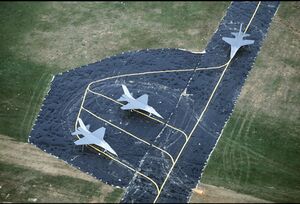
At this point I’m reasonably sure there are things that look like cool alien vehicle in some hangers. But I also grew up near Hollywood and remember super cool looking fake space cars visible off the Hollywood freeway.
So: does anyone have stories of building fake UFOs for USG?

As you likely guessed, all the photos in this thread are fake military equipment. The airbase is totally fake. The dummy tanks are often inflated on the battlefield. The fake tank pieces are bolted on to real cars.
Q: Did we build fake UFOs in places like Wright-Patterson AFB?

After studying this issue for 2yrs, I’m pretty convinced that there ARE wild looking vehicles in secret high security locations. But I also find NO SIGN OF OUR TOP PHYSICISTS. That is a huge red flag. If you had fake UFOs, you would have a puzzle for physics: What is the science?
A true recovered interstellar craft would be like LHC or LIGO data: potential scientific data for physics beyond the Standard Model and General Relativity.
But if the crafts are fake, you would be crazy to let the A-team physicists near them. It would blow up in your face.
So my ignorant question is this: are there stories of building fake UFOs for sites in Nevada? Ohio? Are there fake retrieval teams? To what extent does faking military equipment spill into faking a UFOgasm for decades?
Because there are too many very similar craft stories.
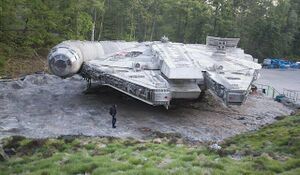
So, at this point, the stories of craft kept at secret locations is most likely to be true in my opinion. But it is also true that all the top physics talent that was working only semi-covertly on suspicious gravity projects left by the early 1970s. So any craft may be faked.
Either way, it’s a big deal. Everything changed in the early 70s. It’s impossible to say how much. The moment the Mansfield amendment came in, physics began to stagnate. And “Quantum Gravity” destroyed our culture of science. We don’t even whisper about its “Anti-Gravity” origin.
Note Added: many readers are making wild inferences about me talking about flying fakes. I was very clear that this was about apparent crafts on the ground and in Hangars in Nevada, Ohio & elsewhere.
Wild or bad inference patterns will get you blocked. I don’t have time. Thx.
2025[edit]
The title of this @joerogan clip from #1945 is literally: "We might be faking a UFO situation."
OBVIOUSLY.
As I have said before, "When we do something secret and cool, we generally pair it with something fake." This is standard operating proceedure (e.g. Operation Overlord was D-Day/Operation Fortitude was a Faked Norway Invasion). This is what 'Covert' means. Covert means 'Deniable'. Not secret, but *deniable*.
BOMBSHELL: Pentagon created fake UFO evidence, promoted false alien stories https://nypost.com/video/bombshell-pentagon-created-fake-ufo-evidence-promoted-false-alien-stories/
Imho, This @nypost article is **NOT** the big story. That is coming.
CLAIM: We will find that there is a minimum of *one* pair of fake/real programs and that it is much much bigger than the hazing ritual being reported. But, more importantly, there are likely many more such pairs of REAL/FAKE programs in this area.
Yes: we fake UFOs. And yes, there is a REAL Aerospace program that hides under cover of the FAKE UFO program.
But this is not about an Air Force Hazing ritual. This isn't a prank. This is a whole life ruining program where we will find that we regularly destroy the minds of our own people with disinformation and threats to their mental health and families. Military heroes. Scientists. IC spooks.
The real FAKE programs are bigger than this. And the REAL program is also bigger than just conventional Aerospace. I wish to mark this claim now: eventually, this is going to be about the actual SCIENCE of Physics.
I don't think Quantum Gravity as it is practiced is a real research program. It is the obvious candidate for the "inhibitor" that, when added to research, stagnated physics...and it didn't come out of some longstanding program from the birth of quantum mechanics. It came out of nowhere right before we stopped making progress on the Lagrangian of the real world.
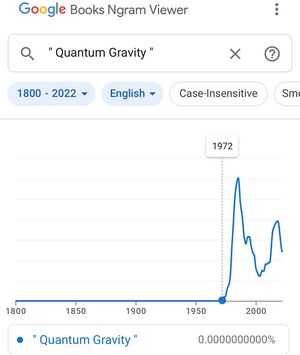
This is going to explain what @pmarca keeps talking about with @bariweiss, @bhorowitz and others: we took whole areas of physics off line after the Manhattan project and that was *NOT* limited to just the Nuclear Physics of nuclear warheads.
CLAIM: These FAKE and REAL programs will keep going and extend to "The Golden Age of General Relativity". We will eventually learn that the mysterious philathropists Roger Babson and Agnew Bahnson who funded Louis Witten and Bryce deWitt (respectively), along with others were (obviously) NationalSecurity cutouts. They were real people giving cover to some major Post-Manhattan physics thing.
From Australian Intelligence (circa 1971) we have this which I both believe and hypothesized LONG before finding it:
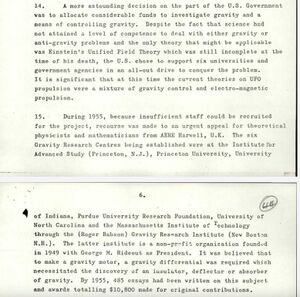
It's time to come clean. The disclosure is coming. One way or the other. A so-called "Limited Hangout" is impossible in 2025. This is not going to work. There is too much information out here already:
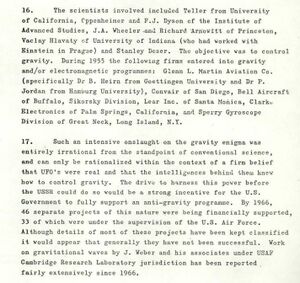
Claim: We are going to learn that just as public work on chain reaction physics mysteriously vanished during the Manhattan Project, research in fundamental physics changed character TWICE. Once in the late 1960s-early 1970s with the Mansfield Amendment, after the quark model and spontaneous symmetry breaking and then more dramatically around 1983-1984 shortly after the catastrophic disclosures of Howard Borland and John Aristotle Philips to handle the "Streisand Effect" problem, which had no such name at the time.
Eventually we learned why progress immediately stalled in physics due to secrecy and the building of the atomic bombs. We have an obvious second candidate and we aren't allowed to ask questions about why we aren't getting back to real physics in open universities. The dangerous and powerful kind that can build prosperity, weapons, energy, travel, propulsion and insight.
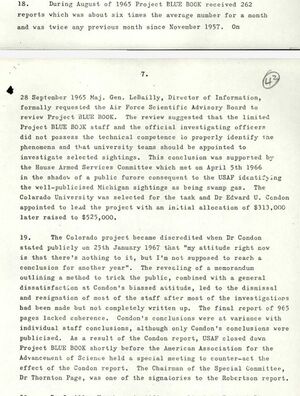
We have now found out that we were lying to our own people. As I predicted to you all.
I predict that this is **way** more interesting. This revelation about the lies is just the beginning. And it may have nothing whatsoever to do with NHI or flying saucers.
But either way, let us be bold enough to ask for the *full* lie. About our own history. Our science. Our Intelligence Community. Our Defense Contractors.
It's our country after all. At least supposedly...
🙏
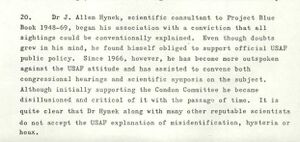
We have been gaslighting our own people. Why do you wish to be part of this AFTER we started getting admissions that this is real?
Here @MickWest @EricRWeinstein from Leslie Kean’s 2010 book UFOs: Generals, Pilots and Government Officials Go on the Record, her list of what constitutes “roughly 90 to 95 percent of UFO sightings”:
"weather balloons, flares, sky lanterns, planes flying in formation, secret military aircraft, birds reflecting the sun, planes reflecting the sun, blimps, helicopters, the planets Venus or Mars, meteors or meteorites, space junk, satellites, swamp gas, spinning eddies, sundogs, ball lightning, ice crystals, reflected light off clouds, lights on the ground or lights reflected on a cockpit window, temperature inversions, hole-punch clouds..."
So the entire ETI hypothesis for explaining UFOs and UAPs is based on a residue of data left over after the above list has been exhausted. What’s left? Not much.
And for Grokers out there:
USAP = Unacknowledged Special Access Program
In the above. Our pilots, CIA officers, geospatial intelligence teams are not all merely seeing seagulls huffing swamp gas out of Mylar balloons at twilight with Venus close to the horizon. https://t.co/wti6or3zy7
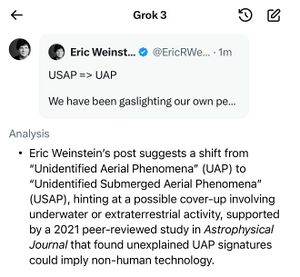

I have no idea how many things we are lying about under the broad UFO/UAP banner.
But gravitational physics in the 1953-early 1970s is one of them. Aerospace is a second. CIA office of Global Access was another. Etc. We are lying about a lot. And that is fine up to a point. National Security can’t be open.
Gaslighting our own best people? I draw the line there. You totally lost me when you gaslit our own people as unstable conspiracy theorists and mentally unstable because you can’t keep secrets from crossing people’s paths.
This is the realm of scoundrels. How can you have National Security when you torment your own A-team? This is insanity.
I would like to talk to @MickWest and @michaelshermer and @francis_collins and @neiltyson and @seanmcarroll and @nytimes about the role of debunking and discrediting professionals who do not buy into narratives that are later found to be cover stories about national interest.
For the first time since JFK’s assassination nearly 62 years ago, the CIA tacitly admitted Thursday that an agent specializing in psychological warfare, George Joannides, ran an operation that came into contact with Lee Harvey Oswald before the killing. https://www.axios.com/2025/07/05/cia-agent-oswald-kennedy-assassination
We have a COVID=Wet Market narrative.
We have an Inflation and CPI narrative.
We have a Quantum Gravity narrative.
We have a Vaccine Narrative.
We have “Americans suck at STEM”.
We have a “Settled Science” narrative.
We have a “Peer Review” narrative.
We had a “Great Moderation” narrative.
We have “Independent Journalism”.
We have a “Disgraced Financier” story.
We have an “Aerospace and UFO” opera.
It’s all one thing that cannot be named:
National Interest “Managed Reality.”
We need to talk about what debunking was before it became “Covert influence operations”, “Image Cheapneing”‘and personal destruction warfare.
So let’s talk.
Are you buying into Anna Paulina Luna's narrative regarding Joannides?
Or Morley's? Posners? Ratcliffe's?
Which one do you pick, and why?
This is part of the problem with debunking.
You see, I don’t know what Covid is. Is it a science project? A miraculous spontaneous mutation? A bioweapon leak?
I don’t know.
But what I do know was that there was TREMENDOUS pressure to say something false about the Wuhan Labs.
Likewise here: I don’t know what happened in Dallas. What I feel confidence in is that we have been lying about telling all we know about what happened in Dallas.
Same with UFOs. What do I know? Very little. But what little I do know is that too many grownups in Govt are talking about something real. That real thing could be a fake program. Or cover for physics research. Or many things.
But the debunking thing has a different energy. I appreciate all you do to explain videos and sightings that have genuinely prosaic explanations. Truly.
What I don’t believe at all is that there is no use of UFO SAPs by the USG. I think we create SAPs and we ruin people’s lives around them when good folks can’t let go of the fact that they saw or experienced or interacted with something we know a lot about.
That’s my issue. Discrediting behavior targeted on individuals to protect programs with claims of national interest.
What exactly are you suggesting with this "different energy"?
That I'm just not polite enough?
Or that I'm part of a disinformation campaign?
Because I'd argue against both of those.
Something else?
I think you are avoiding the reality that at a minimum, our government(s) is/are almost certainly faking a UFO/NHI presence from time to time. That we have UFO/NHI SAPs that we deny. That UFO/NHI is used as cover for aerospace at a minimum. That we do harm to our own people by pretending that everything has a prosaic explanation.
And that you are not debunking the govt bunk (at a minimum).
My issue is treating our own people like garbage. I despise gaslighting our own people. And the energy you bring is that we don’t need to go to that layer.
Again: I’m the only guy in UFO space who has seen nothing conclusive about NHI. I’m with you on that.
But I do think there was a secret serious physics research program that was affiliated with this UFO anti-gravity stuff. I think Roger Babson and Agnew Bahnson were likely CIA or IC cutouts. I think this is all bound up in the “Golden Age of General Relativity”.
And I wish you would stop pretending it’s all innocent mistakes, coincidences, people making silly claims. A lot of it is. Sure.
But after you strip that off, a lot of what’s left is toxic NatSec gaslighting. And if you can’t face that I’d prefer you stop. Because you then hurt the people who got gaslit.

I am not avoiding that. We should absolutely look into topics like Yankee Blue, and Grusch's claims.
I don't treat people like garbage. When I engage with people I do so with facts, logic, and respect. I wrote a book on doing just that.
You're waving around a straw man.
Let’s find out if true.
Do you believe that the U.S. may have created “Craft?” Like deliberate mock ups in hangars.
I do. I think it is likely that some of our people had *real* run-ins with fake craft.
Do you believe that there are *real* stories from our top people and ordinary joes about fake aerial events? Like where we know what people saw, and yet we tell them it was nothing. Like a seagull. Or a contrail. Or Venus. Or a Mylar balloon.
I do. And that is where I part company with you often. Not because you are mean. But because I don’t want this done to our own people, and I have never seen you aggressively go after this. If I am wrong, you have my apology in advance. Happy to make it.
Do you believe that the U.S. maintained a secret zero insignia airforce that operated by descending on citizens collecting information, and destroying and confiscating equipment / data and that it physically intimidated US citizens in large empty western states near testing areas without identifying itself?
I do. And it is so unbelievable that I didn’t think this was possible until friends reported it happened to them. I believe that this had to do with the CIA office of “Global Access”.
Do you believe that @pmarca and @bhorowitz were told that entire areas of theoretical physics were taken off line by the Biden Whitehouse, while researchers have been in 52 year denied stagnation in Standard Model Physics? Which makes no sense. Why aren’t we trying new things???
I do. And there has been bizarre lack of interest for any major news desk to get to the bottom of this claim.
Do you believe that there was a giant secret anti-gravity program, attached to UAP, with many of the world’sbtop physicists within it? And that it was funded by two likely IC cutouts Babson and Bahnson?
I do. It was called the “Golden Age of General Relativity.”
Do you believe that UFOs were cover for aerospace…and that aerospace was cover for physics? And that top physics people were in and out of Aerospace where they had *no* particular reason to be other than secret research?
I do. Like RIAS in Baltimore. And Feynman’s adventures in Buffalo. And L Witten at Wright-Patt. Etc etc.
I’m fed up with being lied to Mick by NatSec incompetents. I have my PhD in this area which is strangely unusable. No one is doing real fundamental research anywhere in physics Mick. Or haven’t you noticed that this changed in 40+ years. It’s like a medieval philosophy cult now.
This is all touching physics. Not Bokeh. Not Mylar. This is largely about the magic and power of a science that gave us god like power and then mysteriously stalled, and now cannot be restarted no matter how cheap and easy it would be to do it.
This (above) is a lot about post Manhattan Project public physics bullshit. Not seagulls.
Some of it is material science. Some of it is nukes. But gravity is in this game. And who knows what else. And quantum gravity is the nonsense we can’t question. The likely cover story if you will.
I don’t care about 👽. I care about NatSec gaslighting of our own PhD level mathematicians and physicists. The children of Teller (Particle Theory), Ulam (Geometry), and Einstein (Gravity). All of whom were central to the Bomb.
Wanna debunk the cover stories? If so I’ll join ya.
"Do you believe that the U.S. may have created “Craft?” Like deliberate mock ups in hangars. "
I don't think it's impossible. I'm not sure WHY they would do it. Maybe to confuse the Russians into thinking we have advanced tech.
"I do. I think it is likely that some of our people had *real* run ins with fake craft."
Entirely possible, at least in hangers.
"Do you believe that there are *real* stories from our top people and ordinary about fake aerial events? Like where we know what people saw and we tell them it was nothing. Like a seagull. Or a contrail. Or Venus. Or a Mylar balloon."
Probably, to a degree, to cover up secret test flights of new tech. We know this happened with the U2. The degree of how much was invented and how much is just allowing organic stories to grow is unclear.
"I do. And that is where I part company with you often. Not because you are mean. But because I don’t want this done to our own people, and I have never seen you aggressively go after this. If I am wrong, you have my apology in advance. Happy to make it."
Aggressively go after what? The military saying things that are not true in order to keep secret stuff secret? Some people getting hurt? Sure, ideally that wouldn't happen. But also ideally, we'd have universal health care, the lack of which ruins many more lives than hyper-rare UFO-themed cover-ups. Yes, I'd prefer less lying and fucking with people, but forgive me if I don't get too excited about such a minor (albeit very interesting) issue.
"Do you believe that the U.S. maintained a secret zero insignia airforce that operated by descending on citizens collecting information and destroying and confiscating equipment and data and physically intimidated US citizens in large empty western states without identifying itself?"
I have no idea. Probably in the past, back when the cold war and nuke secrets were a big deal. There's the singular Bennewitz case 40 years ago (driven insane, or already part-way there?). But now? I really don't see it.
"I do. And it is so unbelievable that I didn’t think this was possible until friends reported it happened to them. I believe that this had to do with the CIA office of “Global Access”."
What happened to them? Vague stories are not helpful.
"Do you believe that @pmarca and @bhorowitz were told that entire areas of theoretical physics were taken off line by the Biden Whitehouse, while we have been in 52 year denied stagnation in Standard Model Physics? "
No. I'd like to see some evidence of this.
"I do. And there has been bizarre lack of interest for any major news desk to get to the bottom of this claim. "
It's because it's a cool but implausible-sounding story with no evidence.
"Do you believe that there was a giant secret anti-gravity program, attached to UAP, with many of the worlds top physicists within it? And that it was funded by two IC cutouts Babson and Bahnson? I do. It was called the “Golden Age of General Relativity.”"?
Sure, but the question is if they actually found anything. I'm not seeing any evidence of this. The stagnation of Standard Model Physics might simply be because the reality of physics is rather boring and incapable of actually giving us anti-gravity flying cars and starships. I've seen all the public UFO evidence, and indirectly heard about the secret stuff, and there's no strong case for gravity drives.
"Do you believe that UFOs were cover for aerospace…and that aerospace was cover for physics?"
The former, but again perhaps more "let it happen" than "make it happen"
"And that top physics people were in and out of Aerospace where they had no particular reason to be other than secret research. I do. Like RIAS in Baltimore. And Feynman’s adventures in Buffalo. And L Witten at Wright Patt. Etc etc."
Basic research is essentially speculative, especially in a practical setting. Stick a Feynman in the research department, and good things might happen. Worth a shot. It does not mean they are pushing the bounds of physics.
"I’m fed up with being lied to Mick. I have a PhD in this area which is strangely unusable. No one is doing real fundamental research anywhere in physics Mick. Or haven’t you noticed that this changed in 40+ years. It’s like a medieval philosophy cult now."
So you keep saying. But there have been lots of advances. It's sad they haven't solved gravity or anything revolutionary. But I don't think revolutions in science can simply be guaranteed with bigger and more focused funding. You ascribe this lack of progress to a conspiracy, but maybe it's just because they haven't found anything.
"This is all touching physics. Not Bokeh. Not Mylar. This is largely about the magic and power of a science that mysteriously stalled and cannot be restarted no matter how cheap and easy it would be to do it. "
Well, get Peter to do it then. If it's so easy, why doesn't he just put you in charge, solve gravity, and get to trillionaire?
"This (above) is a lot about post Manhattan Project public physics bullshit. Not seagulls. Some of it is material science. Some of it is nukes. But gravity is in this game. And who knows what else. And quantum gravity is the nonsense we can’t question. The likely cover story if you will."
There are plenty of people questioning quantum gravity. It's a model that seems to work, but has no real empirical evidence. It does not stop people trying other models.
"I don’t care about . I care about gaslighting PhD level mathematicians and physicists. The children of Teller (Particle Theory), Ulam (Geometry), and Einstein (Gravity). All of whom were central to the Bomb. Wanna debunk the cover stories? If so I’ll join ya."
You're going to have to give me some actual evidence that this is a deliberate cover story. Because I'm unconvinced.
I appreciate the thoughtful answer.
I think it come down to this. You write:
“Aggressively go after what? The military saying things that are not true in order to keep secret stuff secret? Some people getting hurt? Sure, ideally that wouldn't happen. But also ideally, we'd have universal health care, the lack of which ruins many more lives than hyper-rare UFO-themed cover-ups. Yes, I'd prefer less lying and fucking with people, but forgive me if I don't get too excited about such a minor (albeit very interesting) issue.”
If I thought that this was a minor issue I might agree with you.
I think we may have just killed millions with an escaped science experiment called “COVID”. I think the government gaslighting its own scientists and intimidating those who refuse the gaslighting is an absolutely major issue. It’s immoral. It’s illegal. And it’s potentially world altering.
Our government is likely by far the most major actor in the science bunko story. And I want bunk out of science. Starting with Nature, Princeton, the Lancet, Harvard, NSF, and Communications in Mathematical Physics.
So that is where we differ. What you are looking at with junky video analysis is helpful. But in my opinion it is the “minor (albeit very interesting) issue”. The major issue is government control of and subordination of science to NatSec disinformation and misinformation. Like COVID.
So we found the source of our issue. I take @pmarca very seriously on this. I want top scientists in the room who can restrain those NatSec people who can’t keep a virus confined to a secure laboratory meant to circumvent our participation in the bioweapns agreements. I want physicists in the room who say “Wait: why are we doing the same thing for decades that clearly doesn’t work while not pursuing other paths?” I want economists saying “But that would be faking a lower inflation number to raise taxes and slash benefits in a way that the public couldn’t grasp.”
And you are more worried about ghost stories spreading unimpeded because people see ordinary things that are just kinda misinterpreted. That’s noble. But I don’t intuit why that is the major issue.
à chacun son goût…
Thx.
The heart of my war on “Neo-Debunkers”.
Old debunkers confined themselves to conmen and bunko artists.
The Neo debunkers don’t hesitate to go against *targets* of covert NatSec bunk & disinformation campaigns.
A real debunker *HAS* to go against NatSec bunk & disinformation.
I think you are avoiding the reality that at a minimum, our government(s) is/are almost certainly faking a UFO/NHI presence from time to time. That we have UFO/NHI SAPs that we deny. That UFO/NHI is used as cover for aerospace at a minimum. That we do harm to our own people by pretending that everything has a prosaic explanation.
And that you are not debunking the govt bunk (at a minimum).
My issue is treating our own people like garbage. I despise gaslighting our own people. And the energy you bring is that we don’t need to go to that layer.
Again: I’m the only guy in UFO space who has seen nothing conclusive about NHI. I’m with you on that.
But I do think there was a secret serious physics research program that was affiliated with this UFO anti-gravity stuff. I think Roger Babson and Agnew Bahnson were likely CIA or IC cutouts. I think this is all bound up in the “Golden Age of General Relativity”.
And I wish you would stop pretending it’s all innocent mistakes, coincidences, people making silly claims. A lot of it is. Sure.
But after you strip that off, a lot of what’s left is toxic NatSec gaslighting. And if you can’t face that I’d prefer you stop. Because you then hurt the people who got gaslit.

On YouTube[edit]
Cobalt and Blue-on-Blue Dynamics[edit]
Within this framework, "Cobalt" programs represent the highest level of compartmentalization. When civilians or uninitiated personnel ("Baby Blue") encounter these programs—often during routine operations—they may:
- Misidentify the phenomenon as unexplained or non-terrestrial.
- Report observations through standard channels, leading to reputational or career repercussions.
- Be subject to internal disinformation or psychological operations to discredit their accounts.
This dynamic is described as "Baby Blue-on-Blue" fratricide—a failure mode within the intelligence and defense structure, where lack of communication between compartments results in friendly targeting, surveillance, or retaliation.
Criticism and Operational Concerns[edit]
The UAP = USAP model raises concerns about:
- Gaslighting of internal experts and personnel: The use of Image Cheapening, FUD Campaigns, Prebunked Malinformation, and Digital Wetwork against cleared or credentialed experts, personnel, and professionals who inadvertently cross paths with USAP activity.
- Lack of institutional accountability: Inability or unwillingness of leadership to reconcile internal inconsistencies due to structural secrecy.
- Damage to human assets: The undermining of credible military, scientific, and intelligence professionals through covert suppression mechanisms.
While secrecy is acknowledged as a necessity in national defense, fratricidal secrecy architectures result in operational dysfunction, unethical practices, policy distortion, and harm to democratic oversight.
Implications[edit]
The hypothesis reframes UAP-related discourse as less about extraterrestrial visitation and more about:
- Information Asymmetry
- Influence Operations
- Compartmentalization failures
- Strategic deception
It suggests that:
- The U.S. government may exploit UAP narratives as plausible deniability.
- Institutional mechanisms exist to contain internal leaks or misattributions, even at the cost of attacking patriotic insiders.
- Public and congressional UAP discourse may be structurally decoupled from the true nature of observed phenomena.
The hypothesis does not claim to resolve the question of non-human intelligence but asserts that a significant portion of UAP data is functionally entangled with human, terrestrial, and clandestine or covert U.S. defense activity.
Related Pages[edit]
- Anechoic Era or Anechoic media
- Anti-Interesting
- Cobalt and Baby Blue-on-Blue
- Follow the Silence
- The Invisible World is First Detected by the Visible World’s Failure to Close
- Map the Silences
- Physics got NERPhed
- Responsible Conspiracy Theorizing
- The Secret History of Anti-Gravity and Quantum Gravity Research
- UAP
- We may be faking a UFO situation
References[edit]
This article is based on interpretations and publicly available commentary, including interviews, podcasts, social media posts, and open-source summaries of Cobalt-related material (see Cobalt and Baby Blue-on-Blue). No classified or proprietary data has been used.
- ↑ "Humanity Needs a Plan B for Survival". The Portal Wiki. 27 March 2025. Retrieved 7 July 2025.
- ↑ "Eric Weinstein "We May Be Faking a UFO Situation..." - Skepticism Over Current State of UFO's". YouTube. 22 February 2023. Retrieved 7 July 2025.

